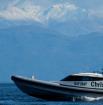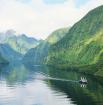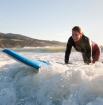Wellington
Wellington may be the coolest capital city in the world. While the Beehive building in the city center houses New Zealand's parliament, these days it's Wellington's vivacious music scene and funky cafes that truly define the city. And while Wellington is home to more culture than most places in NZ, it still offers that natural beauty you rightly expect on a visit to New Zealand.
Wellington is home to Victoria and Massey University, attracting a younger crowd from all over the country to liven things up on the political and party scene. The city offers a plethora of live music venues, as well posh and alternative bars and clubs.
It's not just political big shots and uni students that are attracted to the city, but also celebrities, on and off the silver screen. New Zealand director Peter Jackson chose Weta Digital, whose studios are located just outside of the Wellington city center, to create all the special effects for a little film trilogy called Lord of the Rings in 2001. The studio's work on the film won it a few Oscars and gave Wellington a new nickname, "Wellywood".
With a population of just under 200,000 (as of 2010), Wellington may be small, but it packs a lot of action. Don't be surprised to see Stephen Fry or Elijah Wood waiting in line with you for a coffee, to hear heavy political discussions over wine at the table next to you at dinner or to see the best live show of your life here. Plus, remember to take in the city's natural beauty and popular attractions.
Don't forget to get your accommodation booked before your trip. Check out Wotif for the best deals on Wellington accommodation.
Destination Wellington: Getting There
Wellington is located on the water at the very bottom of New Zealand's North Island, almost exactly in the center of the country. It can be accessed by all means of transportation.
Wellington International Airport makes the city a possible point of arrival into the country. It also offers daily flights to most destinations around the country, including Auckland, Christchurch, Queenstown and Nelson.
The airport is about a ten-minute drive from the city center. With fares starting at $5.50 for adults, the Airport Flyer Bus is an cheap way to get to and from the city and its suburbs. Fares vary on the zone of your destination.
If you're arriving to Wellington after visiting the South Island, or heading to the South Island after visiting Wellington, you'll have to get across the Cook Strait. This is an incredible journey, and arguably the most beautiful ferry crossing in the world. Check out Interislander for the best service in crossing the Cook Strait.
These ferries sail through the Marlborough Sounds and across the Cook Strait on the journey. It's a fantastic experience in and of itself, and sometimes passengers may even spot dolphins or whales. Expect to pay $50-$75 for one way, adult walk-on fares or anywhere from $160 and up for fares including a vehicle. Both companies offer discounts for online bookings, but these deals sometimes do run out, so book early if possible.
Wellington Railway Station, located in the city center, is the final stop on the breathtaking TranzScenic Overlander route from Auckland to Wellington. It also connects the city to surrounding suburbs and various destinations across the North Island. Buses from all over the North Island arrive here as well.
Destination Wellington: Hot Spots
Wellington can be one of the cheaper destinations in New Zealand, because a lot of its activities are free. Be sure to check out any or all of these spots during your time exploring Wellington.
Cuba Street
Named after the Cuba, a settler ship that arrived in Wellington in 1840, this colorful street is a great place to grab a coffee and people watch. Cuba Street is constantly filled with music as street performers are a regular sight. It has an unusual bucket layered fountain in its center which often times wets passer-bys walking too close. Locals living above shops will go out on the rooftops on sunny days.
But Cuba Street is all about its cafe culture. There are plenty of places to get your coffee fix along here, some keeping with the street's Havana theme, others going for a theme of their own (learn more about these places below).
After a coffee and some lunch, those with a few bucks to splurge can go "op-shopping" for used and vintage clothing at places like Recycled Boutique and the Fringe Market at Fringe Bar on weekends. Make sure to buy something fun to wear for your return to Cuba Street at night. Some of Wellington's best bars and music venues reside here (learn more about these places below).
Mount Victoria (free)
At 196 meters Mount Victoria is the tallest point in Wellington. It offers the best view of the city as well as a good workout. Walk up the mountain using the Southern Walkway, which starts at the corner of Victoria and Wakefield Streets at Oriental Bay. For the lazier crowd, it can also be reached by car or bus.
At the top, visitors have a 360 view of the city and its suburbs. Learn about New Zealand's Maori culture, its weather (more specifically its harsh winds) and even its relativity to Antarctica.
This is one of the most iconic activities Wellington has to offer. The red cable car was created in 1898 to help residents reach their homes. Today it is still used by people for this purpose, especially for students of Victoria University as part of the University is located here.
The five-minute cable car ride offers visitors the chance to take part in Wellington's industrial history, but the activity just gets better at the top.
The 25-hectre Botanic Garden offers stunning views of the city as well as the chance to walk through some of the most popular as well as protected native forestry featured around its many trails that lead to the bottom.
While it is possible to get a return cable car ride, it's better to buy a one way ticket up and walk down into town. The recommended route takes about one to two hours to complete and even leads visitors into town by way of Wellington's unusual-looking parliament building, the Beehive.
Museum of New Zealand Te papa Tongarewa
New Zealand's national museum, visitors could spend hours tackling Te Papa's many exhibitions and still not see it all. Te Papa allows its visitors to learn a bit of everything about New Zealand hands on.
Te Papa is a great starting off point to learn about Maori culture. The museum's exhibition Mana Whenua explains how the Polynesian explorers found Aotearoa (the common Maori name for New Zealand meaning "Land of the long white cloud").
In the museum's Awesome Forces exhibition, visitors learn about the geology of New Zealand, a land of mountains, volcanoes and more. People can even feel what it's like to be in a house during an earthquake, something that New Zealanders have had to deal with on several occasions because the country is on a fault line.
Te Papa even has a colossal squid on display. The massive ocean creature was found off the coast of Antarctica by the crew of San Aspiring in February 2007. It was brought back to Te Papa to be researched and put on display. The exhibition explains how the colossal squid was found, its anatomy and more.
Te Papa is located on the waterfront. Before or after visiting the museum take a walk along here. The area has a lot of cafes, bars and restaurants as well as lounging areas and public art displays.
Get out of the city
Wellington's CBD is quite small, but there is plenty more to do on the outskirts of the city center. One of the best ways to explore its more natural bits is a by scenic drive along the water.
The road leads drivers to the surf beaches of Lyall Bay as well as Red Rocks where a seal colony resides.
Not far off the scenic drive is Weta Cave in Miramar. The award-winning studio has worked on the special effects for several films including Lord of the Rings, The Lovely Bones and Adventures of Tin Tin. Studios are closed to visitors but at the front is a small museum that explains the history of the studios and displays memorbilia from many films they have worked on. The museum is free and an essential visit for anyone interested in visiting Lord of the Rings film sites around the country.
Destination Wellington: Food, Drink and Nightlife
Wellington has a heavy cafe culture. Locals embrace independent establishments rather than commercial as they offer unique decor and espresso beans from local roasters, such as Havana Coffee and Flight Coffee. Visitors to the city will see these names and a few more proudly displayed in front of local cafes.
Coffee in the city is an art and baristas here, are like rock stars. Covered in tattoos, head looking down behind a steaming machine, baristas in this city really know how to make a good cup of joe, which will give cafe patrons a reason to hang around places like Fidel's Cafe, Memphis Belle and Sweet Mother's Kitchen even longer and take in the atmosphere.
Wellington food matches the caliber of its coffee too. Wellington has hundreds of cafes and restaurants offering an array of cuisines. It seems most places are almost always busy. Those looking for something cheaper should try one of the city's many kebab or sushi shops. Cafes like the ones mentioned above offer relatively cheap cabinet food and moderately priced items on the menu. If there's a place to splurge on food in New Zealand, it's Wellington, and restaurants like Logan Brown and Duke Carvell's are the place to do it.
Full of uni students and known for its music scene (Fat Freddy's Drop came out of Wellington), the city also offers a great night out for whatever kind of night you fancy. Some great live music venues to check out are San Francisco Bath House and Bodega.
One of the favorite all-around bars among uni students is Mighty Mighty. For a more classy night out, try Matterhorn on Cuba Street and Fox Glove on the waterfront, which offers amazing views as well as a Narnia-style dresser leading to another part of the massive bar. For the more traditional, try bars like Molly Malones and JJ Murphy & Co. These establishments offer everything from cheap food to televised sports to discounted drink deals.
Destination Wellington: Final Thoughts & Recommendations
Wellington has so much to offer its visitors, here are some additional tips on making the most out of your experience and your dollar in the city.
Wellington is called the windy city for a reason. Even on the sunniest of summer days, this city can be very chilly due to wind. Remember to bring a coat, but don't forget to wear sunscreen as well. New Zealand's hard sun is harmful in all temperatures.
Save money by walking instead of taking public transportation. The city center is quite small, making it easy to walk to most attractions. Exploring on foot may also allow you to see more than you would on wheels.
Grab a copy of the Capital Times. This free, local paper comes out weekly and has event listings from all over the city as well as interesting write ups and reviews about the city. It awards the city's hospitality industry with "best of Wellington" every year, so you may see this in the windows of cafes and restaurants.
The city has several hostels and hotels, some of which are reasonably priced, but you might want to try Couchsurfing or even renting a room in someone's flat here. A lot of the houses in Wellington are speckled in hills surrounding the city. Not only will staying with a local increase your experience as they can share more about the city, but staying in one of these places is pretty iconic to Wellington. Plus, renting a room can be quite cheap here.
We think you'll enjoy Wellington; it might just be the coolest capital city in the world.






